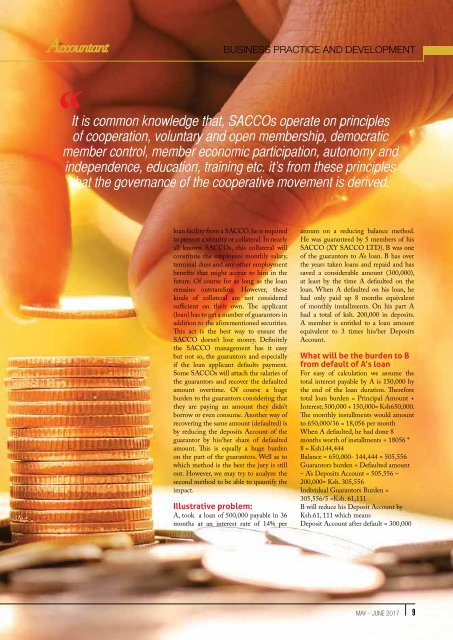The Accountant-May-June 2017
You also want an ePaper? Increase the reach of your titles
YUMPU automatically turns print PDFs into web optimized ePapers that Google loves.
Business Practice and Development<br />
It is common knowledge that, SACCOs operate on principles<br />
of cooperation, voluntary and open membership, democratic<br />
member control, member economic participation, autonomy and<br />
independence, education, training etc. it’s from these principles<br />
that the governance of the cooperative movement is derived.<br />
loan facility from a SACCO, he is required<br />
to present a security or collateral. In nearly<br />
all known SACCOs, this collateral will<br />
constitute the employees monthly salary,<br />
terminal dues and any other employment<br />
benefits that might accrue to him in the<br />
future. Of course for as long as the loan<br />
remains outstanding. However, these<br />
kinds of collateral are not considered<br />
sufficient on their own. <strong>The</strong> applicant<br />
(loan) has to get a number of guarantors in<br />
addition to the aforementioned securities.<br />
This act is the best way to ensure the<br />
SACCO doesn’t lose money. Definitely<br />
the SACCO management has it easy<br />
but not so, the guarantors and especially<br />
if the loan applicant defaults payment.<br />
Some SACCOs will attach the salaries of<br />
the guarantors and recover the defaulted<br />
amount overtime. Of course a huge<br />
burden to the guarantors considering that<br />
they are paying an amount they didn’t<br />
borrow or even consume. Another way of<br />
recovering the same amount (defaulted) is<br />
by reducing the deposits Account of the<br />
guarantor by his/her share of defaulted<br />
amount. This is equally a huge burden<br />
on the part of the guarantors. Well as to<br />
which method is the best the jury is still<br />
out. However, we may try to analyze the<br />
second method to be able to quantify the<br />
impact.<br />
Illustrative problem:<br />
A, took a loan of 500,000 payable in 36<br />
months at an interest rate of 14% per<br />
annum on a reducing balance method.<br />
He was guaranteed by 5 members of his<br />
SACCO (XY SACCO LTD). B was one<br />
of the guarantors to A’s loan. B has over<br />
the years taken loans and repaid and has<br />
saved a considerable amount (300,000),<br />
at least by the time A defaulted on the<br />
loan. When A defaulted on his loan, he<br />
had only paid up 8 months equivalent<br />
of monthly installments. On his part A<br />
had a total of ksh. 200,000 in deposits.<br />
A member is entitled to a loan amount<br />
equivalent to 3 times his/her Deposits<br />
Account.<br />
What will be the burden to B<br />
from default of A’s loan<br />
For easy of calculation we assume the<br />
total interest payable by A is 150,000 by<br />
the end of the loan duration. <strong>The</strong>refore<br />
total loan burden = Principal Amount +<br />
Interest; 500,000 + 150,000= Ksh650,000.<br />
<strong>The</strong> monthly installments would amount<br />
to 650,000/36 = 18,056 per month<br />
When A defaulted, he had done 8<br />
months worth of installments = 18056 *<br />
8 = Ksh144,444<br />
Balance = 650,000- 144,444 = 505,556<br />
Guarantors burden = Defaulted amount<br />
– A’s Deposits Account = 505,556 –<br />
200,000= Ksh. 305,556<br />
Individual Guarantors Burden =<br />
305,556/5 =Ksh. 61,111<br />
B will reduce his Deposit Account by<br />
Ksh.61, 111 which means<br />
Deposit Account after default = 300,000<br />
MAY - JUNE <strong>2017</strong> 9

















